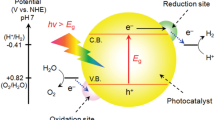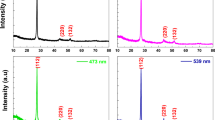Abstract
To improve photoelectrochemical properties of Si nanowires (SiNWs), MoS2/SiNWs is prepared via two-step method. SiNWs is synthesized by metal−catalyzed electroless etching (MCEE) method and MoS2 is subsequently deposited onto SiNWs through the direct thermal decomposition method. MoS2 is introduced as both light absorber and catalyst for hydrogen evolution reaction (HER). Moreover, it forms a heterojunction with SiNWs that contribute to the charge separation. Herein, MoS2/SiNWs attains excellent hydrogen evolution reaction (HER) catalysis with onset potential of 55 mV. A photocurrent density of 25 mA cm− 2 at −1.0 VRHE were achieved under simulated solar illumination, which is about 6 times higher than that of SiNWs, and the carrier concentration is increased by 100−fold. The enhanced photocatalytic activity of MoS2/SiNWs toward HER is attributed to the Schottky junction at the interface, which enhances the photo−generation of electron−hole pairs and suppresses the charge recombination, making them promising earth−abundant alternatives to noble metal−based photocathode for HER.
Similar content being viewed by others
References
Osterloh FE (2013) Inorganic nanostructures for photoelectrochemical and photocatalytic water splitting. Chem Soc Rev 42:2294–2320
Jiang C, Moniz SJA, Wang A et al (2017) Photoelectrochemical devices for solar water splitting – materials and challenges. Chem Soc Rev 46:4645–4660
Li J, Wu N (2015) Semiconductor-based photocatalysts and photoelectrochemical cells for solar fuel generation: a review. Catal Sci Technol 5:1360–1384
Yang J, Walczak K, Anzenberg E et al (2014) Efficient and sustained photoelectrochemical water oxidation by cobalt Oxide/Silicon photoanodes with nanotextured interfaces. J Am Chem Soc 136:6191–6194
Fan R, Mao J, Yin Z et al (2017) Efficient and Stable Silicon Photocathodes Coated with Vertically Standing Nano-MoS2 Films for Solar Hydrogen Production. ACS Appl Mater Interfaces 9:6123–6129
Ding Q, Meng F, English CR et al (2014) Efficient photoelectrochemical hydrogen generation using heterostructures of Si and chemically exfoliated metallic MoS2. J Am Chem Soc 136:8504–8507
Peng W, Rupich SM, Shafiq N et al (2015) Silicon surface modification and characterization for emergent photovoltaic applications based on energy transfer. Chem Rev 115:12764–12796
Peng KQ, Wang X, Li L et al (2013) Silicon nanowires for advanced energy conversion and storage. Nano Today 8:75–97
Sim U, Jeong H -Y, Yang T -Y, Nam KT (2013) Nanostructural dependence of hydrogen production in silicon photocathodes. J Mater Chem A 1:5414
Qiao S, Cong R, Liu J et al (2018) Vertical layered MoS2/Si heterojunction for ultrahigh and ultrafast photoresponse photodetector. J Mater Chem C 6:3233–3239
Wu D, Lou Z, Wang Y et al (2017) Construction of MoS2/Si nanowire array heterojunction for ultrahigh-sensitivity gas sensor. Nanotechonology 28:0–9
Jian W, Cheng X, Huang Y et al (2017) Arrays of ZnO/MoS2 nanocables and MoS2 nanotubes with phase engineering for bifunctional photoelectrochemical and electrochemical water splitting. Chem Eng J 328:474–483
Wang H, Zhang L, Chen Z et al (2014) Semiconductor heterojunction photocatalysts: design, construction, and photocatalytic performances. Chem Soc Rev 43:5234
Ding Q, Song B, Xu P, Jin S (2016) Efficient Electrocatalytic and Photoelectrochemical Hydrogen Generation Using MoS2 and related compounds. Chem 1:699–726
Jin H, Guo C, Liu X et al (2018) Emerging two-dimensional nanomaterials for electrocatalysis. Chem Rev https://doi.org/10.1021/acs.chemrev.7b00689
Zhang G, Liu H, Qu J, Li J (2016) Two-dimensional layered MoS2?: rational design, properties and electrochemical applications. Energy Environ Sci 9:1190–1209
Benson J, Li M, Wang S et al (2015) Electrocatalytic hydrogen evolution reaction on edges of a few layer molybdenum disulfide nanodots. ACS Appl Mater Interfaces 7:14113–14122
Kibsgaard J, Chen Z, Reinecke BN, Jaramillo TF (2012) Engineering the surface structure of MoS2 to preferentially expose active edge sites for electrocatalysis. Nat Mater 11:963–969
Jaramillo TF, Jorgensen KP, Bonde J et al (2007) Identification of active edge sites for electrochemical H2 evolution from MoS2 nanocatalysts. Science 317:100–102
Hu J, Huang B, Zhang C et al (2017) Engineering stepped edge surface structures of MoS2 sheet stacks to accelerate the hydrogen evolution reaction. Energy Environ Sci 10:593–603
Parija A, Choi Y-H, Liu Z et al (2018) Mapping catalytically relevant edge electronic states of MoS2. ACS Cent Sci, https://doi.org/10.1021/acscentsci.8b00042
Kasowski RV (1973) Band structure of MoS2 and NbS2. Phys Rev Lett 30:1175–1178
Mattheiss LF (1973) Band structures of transition-metal-dichalcogenide layer compounds. Phys Rev B 8:3719–3740
Kim TY, Amani M, Ahn GH et al (2016) Electrical properties of synthesized large-area MoS2 field-effect transistors fabricated with Inkjet-printed contacts. ACS Nano 10:2819–2826
Qiao S, Zhang B, Feng K et al (2017) Large lateral photovoltage observed in MoS2 thickness-modulated ITO/MoS2/p-Si heterojunctions. ACS Appl Mater Interfaces 9:18377–18387
Electroanal J (1977) Electrochemistry and photochemistry of MoS2 layer crystals. I. J Electroanal Chem 81:97–111
Wilcoxon JP, Thurston TR, Martin JE, Labs SN (1999) Application of metal and semiconductor as thermal and photo-catalysts. NanoStructured Material 12:993–997
Thurston TR, Wilcoxon JP (1999) Photooxidation of organic chemicals catalyzed by nanoscale MoS2. J Phys Chem B 103:11–17
Chen Z, Forman AJ, Jaramillo TF (2013) Bridging the gap between bulk and nanostructured photoelectrodes: the impact of surface states on the electrocatalytic and photoelectrochemical properties of MoS2. J Phys Chem C 117:9713–9722
Meng F, Li J, Cushing SK et al (2013) Solar hydrogen generation by nanoscale p-n junction of p-type molybdenum disulfide/n-type nitrogen-doped reduced graphene oxide. J Am Chem Soc 135:10286–10289
Oh S, Kim JB, Song JT et al (2017) Atomic layer deposited molybdenum disulfide on Si photocathodes for highly efficient photoelectrochemical water reduction reaction. J Mater Chem A 5:3304–3310
Zhang L, Liu C, Wong AB et al (2014) MoS2-wrapped silicon nanowires for photoelectrochemical water reduction. Nano Res 8:281–287
Hamdi A, Boussekey L, Roussel P et al (2016) Hydrothermal preparation of MoS2/TiO2/Si nanowires composite with enhanced photocatalytic performance under visible light. Mater Des 109:634–643
Trung TN, Seo DB, Quang ND et al (2018) Enhanced photoelectrochemical activity in the heterostructure of vertically aligned few-layer MoS2 flakes on ZnO. Electrochim Acta 260:150–156
Teng W, Wang Y, Huang HH et al (2017) Enhanced photoelectrochemical performance of MoS2 nanobelts-loaded TiO2 nanotube arrays by photo-assisted electrodeposition. Appl Surf Sci 425:507–517
He H, Lin J, Fu W et al (2016) MoS2/TiO2 edge-on heterostructure for efficient photocatalytic hydrogen evolution. Adv Energy Mater 6:1–7
Guo L, Yang Z, Marcus K et al (2017) MoS2/TiO2 heterostructures as nonmetal plasmonic photocatalysts for highly efficient hydrogen evolution. Energy Environ Sci 11:106–114
Zhang S, Tang F, Liu J et al (2017) MoS2-coated ZnO nanocomposite as an active heterostructure photocatalyst for hydrogen evolution. Radiat Phys Chem 137:104–107
Xu H, Yi J, She X et al (2018) 2D heterostructure comprised of metallic 1T-MoS2/Monolayer O-g-C3 N 4 towards efficient photocatalytic hydrogen evolution. Appl Catal B: Environ 220:379–385
Hou Y, Zhu Z, Xu Y et al (2017) Efficient photoelectrochemical hydrogen production over p-Si nanowire arrays coupled with molybdenum–sulfur clusters. Int J Hydrogen Energy 42:2832–2838
Hsieh S, Ho S, Chen W (2016) Silicon nanowires with MoSx and Pt as electrocatalysts for hydrogen evolution reaction. J Nanomater 120:1165–1171
Bao X, Petrovykh D, Alpuim P et al (2015) Amorphous oxygen-rich molybdenum oxysulfide decorated p-type silicon microwire Arrays for efficient photoelectrochemical water reduction. Nano Energy 16:130–142
Hu D, Xiang J, Zhou Q et al (2018) One-step chemical vapor deposition of MoS2 nanosheets on SiNWs as photocathodes for efficient and stable solar-driven hydrogen production. Nanoscale 10:3518–3525
Oh S, Kim J, Song J et al (2017) Atomic layer deposited molybdenum disulfide on Si photocathodes for highly efficient photoelectrochemical water reduction reaction. J Mater Chem A 5:3304–3310
Author information
Authors and Affiliations
Corresponding author
Rights and permissions
About this article
Cite this article
Qiao, L., Liao, M., Fang, K. et al. Enhancement of Photoelectrochemical Hydrogen Evolution of P-Type Silicon Nanowires Array by Loading MoS2. Silicon 11, 1963–1970 (2019). https://doi.org/10.1007/s12633-018-0014-y
Received:
Accepted:
Published:
Issue Date:
DOI: https://doi.org/10.1007/s12633-018-0014-y




